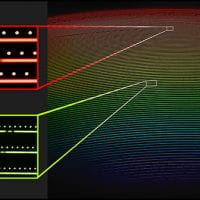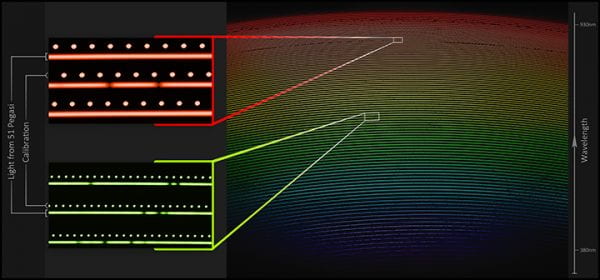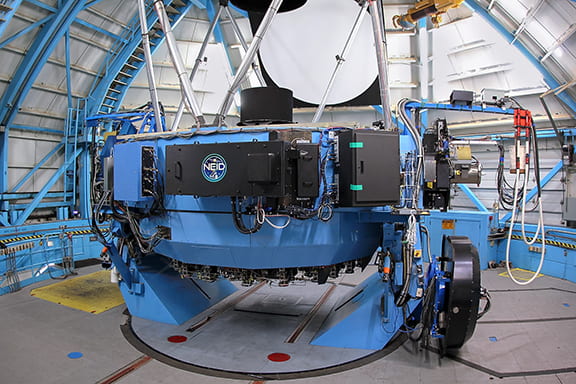NEID Spectrograph Sees First Light

The exoplanet-hunting instrument NEID, designed and built at Penn State, has passed an important milestone on the road to discovering Earth-mass planets beyond our solar system. The new instrument, an extreme precision radial velocity spectrometer, has been installed on the 3.5-meter WIYN telescope at Kitt Peak National Observatory (KPNO) in Southern Arizona, a program of the NSF’s National Optical-Infrared Astronomy Research Laboratory (OIR Lab), and has made its first observations collecting starlight.
The NSF-NASA funded instrument is designed to measure the motion of nearby stars with extreme precision—roughly three times better than the previous generation of state-of-the-art instruments—allowing researchers to detect, determine the mass of (‘weigh’), and characterize exoplanets as small as Earth.
NEID detects exoplanets by measuring the subtle effect these planets have on their parent stars. Planets tug gravitationally on the stars they orbit, producing a small “wobble”—a periodic shift in the velocity of the star. This happens in our own solar system—Jupiter causes the Sun to wobble at roughly 13 meters/second (about 43 feet/second: only a bit faster than record-breaking sprinter Usain Bolt!), whereas the Earth causes a movement with a velocity of only 0.1 meters/second (less than 4 inches/second). The amplitude of the wobble is proportional to an orbiting planet’s mass, meaning NEID measurements can be used to determine the masses of exoplanets. Most current instruments can measure velocities as low as 1 meter/second (just over 3 feet per second: a slow walking pace), but NEID was built to detect even lower velocities—potentially uncovering Earth-mass exoplanets.

The first light image of the spectrum of 51 Pegasi as captured by NEID on the WIYN telescope. The image shows the light from the star, highly dispersed by NEID, from short wavelengths (bluer colors) to long wavelengths (redder colors). The colors shown, which approximate the true color of the starlight at each part of image, are included for illustrative purposes only. The region in the small white boxes, when expanded, shows the spectrum of the star (longer dashed lines) and the light from the wavelength calibration source (dots). Deficits of light (dark interruptions) in the stellar spectrum, are due to stellar absorption lines — “fingerprints” of the elements that are present in the atmosphere of the star. By measuring the subtle motion of these features, to bluer or redder wavelengths, astronomers can detect the “wobble” of the star produced in response to its orbiting planet. Credit: Guðmundur Kári Stefánsson/Princeton University/Penn State/NSF’s National Optical-Infrared Astronomy Research Laboratory/KPNO/NSF/AURA
“In the last decade the state of the art has been roughly 1 meter/second,” explains Jason Wright, professor of astronomy and astrophysics and NEID Project Scientist at Penn State. “NEID is expected to do about three times better, pushing the envelope to higher precision.”
Already an impressive exoplanet-hunting machine, NEID will become even more powerful in partnership with space observatories such as the Transiting Exoplanet Survey Satellite.
“When we combine future NEID observations with data from spacecraft, things will really get interesting, and we will be able to learn what planets are made of,” said Wright. “We will know the planet’s density, which is a clue to understanding how much of an atmosphere the planet has; is it gaseous like Saturn, an ice giant like Neptune, rocky like Earth, or something in between—a super-Earth or sub-Neptune?”
To allow NEID to make these measurements requires extreme precision. Starlight collected by the WIYN telescope is fed by an optical fiber to a thermal enclosure encasing the NEID instrument. To ensure that NEID measurements remain consistent over the instrument’s five-year lifetime, its optics are held at a fixed temperature that is stable to within a thousandth of a degree.
NEID’s first-light observations targeted the star 51 Pegasi, which in 1995 became the first Sun-like star found to host an exoplanet. “‘First light’ is an important milestone in an instrument’s development,” said Wright. “It is the first verification that NEID is measuring starlight as expected and is on its way to full functionality.”
NEID’s capabilities are particularly impressive given how quickly the instrument went from the drawing board to first light, less than four years. “NEID is a great opportunity to push precision measurement of a star’s radial velocity significantly further than before,” said Fred Hearty, NEID’s project manager and a senior scientist at Penn State.

The WIYN telescope at Kitt Peak National Observatory. Credit: NSF’s National Optical-Infrared Astronomy Research Laboratory/KPNO/NSF/AURA
While NEID is designed to study exoplanets, it must contend with the small-scale motion of the churning plasma at the surfaces of stars, a phenomenon which creates signals that can mask or even mimic planetary signals. Distinguishing between the two is a challenge that excites stellar astrophysicists. NEID’s scientific output will be further increased by making the instrument widely available to astronomers, in contrast to other precision radial velocity spectrometers.
“The precision of NEID’s hardware has already started opening up a new era for state-of-the-art precision radial velocity measurement algorithms,” said Joe Ninan, an assistant research professor of astronomy and astrophysics at Penn State. “After many years of work, it is heartening to finally start dealing with NEID data.”
“The NEID project offers the opportunity to work with a talented and dynamic team, to train the next generation of experimentalists, and to develop a discovery machine that all astronomers can apply to use, regardless of nationality, institution or rank,” said Suvrath Mahadevan, professor of astronomy and astrophysics at Penn State and principal investigator of NEID. “First Light is an important milestone in the continuing set of commissioning tasks to demonstrate NEID’s measurement precision in the months ahead.”
Exoplanets discovered with NEID will be potential targets for follow-up observations with upcoming facilities like NASA’s James Webb Space Telescope, which will be able to detect and characterize the atmospheres of exoplanets. This makes NEID an important part of the ongoing search for other earths, and brings scientists one step closer to determining if there are truly Earth-like planets elsewhere in the Galaxy.
NEID takes its name from the Tohono O’odham word meaning “to see.” Kitt Peak National Observatory is located on Tohono O’odham land. NEID is also a nested acronym for NN-EXPLORE Exoplanet Investigations with Doppler spectroscopy. The Name NEID was selected after consultation with the Tohono O’odham Nation.
More information
The astronomical community is honored to have the opportunity to conduct astronomical research on Iolkam Du’ag (Kitt Peak) in Arizona. We recognize and acknowledge the very significant cultural role and reverence this site has to the Tohono O’odham Nation.
The NEID instrument is funded by the joint NASA/NSF Exoplanet Exploration Program, NN-EXPLORE. The 3.5-meter WIYN Telescope is a partnership among Indiana University, the University of Wisconsin, Penn State , the University of Missouri-Columbia, Purdue University, the NSF, and NASA.
Media Contacts:
Suvrath Mahadevan, Professor of Astronomy and Astrophysics, suvrath@astro.psu.edu, (814) 865-0261
Jason Wright, Professor of Astronomy and Astrophysics, jtwright@astro.psu.edu, (814) 863-8470
Sam Sholtis, Science Writer, samsholtis@psu.edu, (814) 865-1390
Source: https://science.psu.edu/news/Mahadevan1-2020




